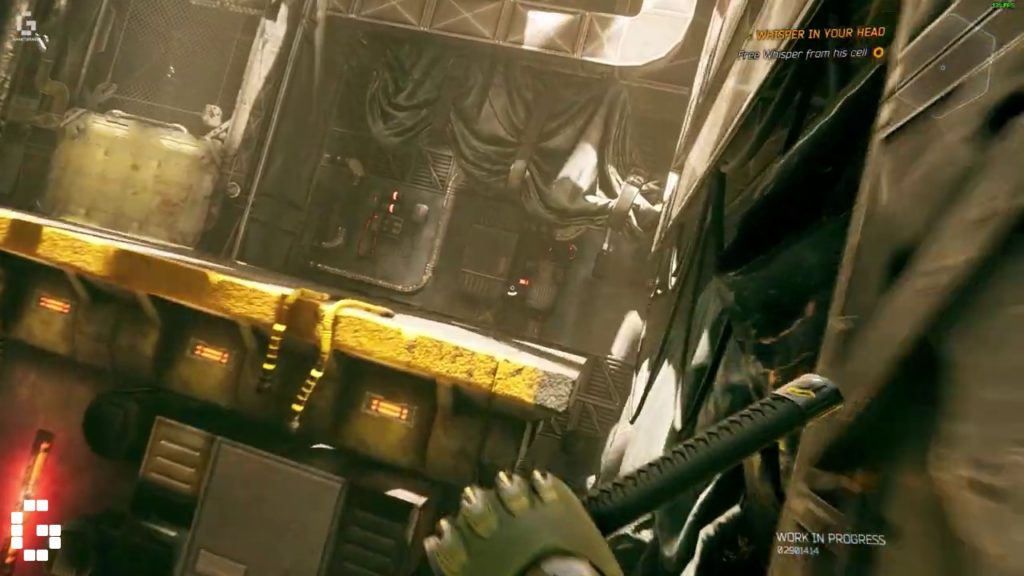There are two things that are always cool- ninjas and robots. In the upcoming Ghostrunner, due later this month, you play as the cybernetic Ghostrunner who embodies both of these. We got our hands on a preview build of the Action-Puzzler thanks to our friends at 505 Games, so let’s jump in and find out exactly how much fun wall running to a synthwave beat can be.

Big Dharma
Right off the bat, the world of Ghostrunner is incredibly gorgeous. It follows a growing trend of games to adopt a cyberpunk aesthetic, specifically with a Japanese-leaning art direction. The titular Ghostrunner looks and feels a lot like Overwatch’s Genji- not a flaw, since the gameplay almost seems like an expanded take on playing that character.
Similarly, the game’s soundtrack features a very industrial-sounding synthwave beat. It meshes very well with the aesthetic, though it doesn’t produce anything particularly memorable. That being said, it’s a good soundtrack to be running along walls to.
The game takes place in Dharma Tower- a futuristic tower-like mega city. From the preview, it’s clear the game’s story will involve getting to the top of this tower. This is by and large the coolest part of the game’s setting, especially since most of its stages have that feel of looming verticality. The bottomless pits, the floating platforms- all of these give off the vibe of being not quite at ground level.
As for the game’s actual plot, it doesn’t do anything particularly interesting. It borrows a lot of science fiction terms, with characters like The Architect and Keymaster, and from what we seen it sounds like the game’s story won’t really take any twists anyone familiar with the genre isn’t already expecting.

You Like To Move It
Considering it’s a game all about its mobility, it’s no surprise that the mobility in this game feels really good. It seems like the game has cherry picked all the best innovations in first-person mobility. Your character has access to wall running, airdashes and grapple points. You also have the additional bonus of autoclimbing when near ledges, which is convenient since it gives you more of a window for failure.
The combat in this game is fairly simple, though that helps you focus on the game’s mobility. Enemies will flash when they can be killed, and when they do, you do it in one. Considering this is more puzzle-platformer first, I don’t really mind the simplistic combat. After all, movement in the game already feels so good, having a more involved combat system would have only taken away from it.
Similar to the enemies, you go down in one, too. However, this doesn’t mean you should hide. Rather, this should be even more motivation for you to stay moving. First of all, the game doesn’t even give you cover. So anything that looks like you could use to hide is probably pointless anyways. Secondly, you’re safe for a good portion of your dash, so it’s a good time to make liberal use of it.
While the game kills you off fairly easily, that’s no cause for despair. It’s quite liberal with its checkpoints, and you rarely ever loose more than one encounter’s progress on death. Considering how quickly you die, this is pretty important. More importantly, the game’s soundtrack continues even when you die and restart, so you can tell some care was taken into player experience when making these levels.

Getting You With The Mix-Ups
Of course, a big problem with platforming is how the developers will choose to mix things up. Here comes my biggest gripe with the preview so far. Part of the game’s story has you in a place called the Cybervoid. The Cybervoid sequence they show you here has no real fast challenges. Rather, the only way to die here is to not be able to spot the blue path against its blue background. It gets worse than that, though- the blue platforms aren’t even entirely solid, instead looking like invisible platform with blue traces on them.
Considering how much of the game is fast-paced, the sudden shift to a slow sequence where I have to mind my toes is quite unpleasant. It’s made worse by the fact that the Cybervoid sequence in the demo is a vehicle for exposition, and it’s not like the world of Ghostrunner is particularly interesting. As mentioned before, it’s not like it’s bad, it just doesn’t appear to be anything that hasn’t been done before.

Final Thoughts
Despite some gripes, Ghostrunner looks like its going to be a good time. Its focus on mobility and gorgeous environments are a good example of playing to its strengths, and done properly could very well overpower the flaws we’ve seen so far.
As a preview build, Ghostrunner shows a lot of promise. All the notes I’ve brought up so far could very well just be due to the limited level selection of the demo, and as long as the game keeps to its core loop, it could very well bring platforming-based games back into popular focus. Ghostrunner releases on PS4, Xbox One and PC on October 28th.


![[GUIDE] Heaven Burns Red Tier List](https://cdn.gamerbraves.com/2024/11/Heaven-Burns-Red-Tier-List_Guide_FI-360x180.jpg)
![[GUIDE] Soul Land: New World Tier List](https://cdn.gamerbraves.com/2024/11/Soul-Land-Tier-List_Guide_FI-360x180.jpg)












![[gamescom asia 2024] EXCLUSIVE: Oil King’s Rise from EVO Champion to a Fighting Game Icon!](https://cdn.gamerbraves.com/2024/11/Oil-King-Interview-SF6_FI-360x180.jpg)
![[gamescom asia 2024] EXCLUSIVE: GamerBee Shares His Professional Journey – Over 10 Years in Street Fighter](https://cdn.gamerbraves.com/2024/11/GamerBee-Interview-SF6_FI-360x180.jpg)








